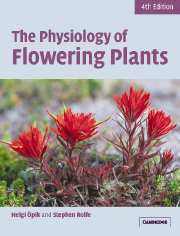Book contents
- Frontmatter
- Contents
- Preface
- Chapter 1 Introduction
- Part I Nutrition and transport
- Part II Growth and development
- Chapter 6 Growth as a quantitative process
- Chapter 7 Plant growth hormones
- Chapter 8 Cell growth and differentiation
- Chapter 9 Vegetative development
- Chapter 10 Photomorphogenesis
- Chapter 11 Reproductive development
- Chapter 12 Growth movements
- Chapter 13 Resistance to stress
- Appendix
- Index
- References
Chapter 8 - Cell growth and differentiation
Published online by Cambridge University Press: 05 June 2012
- Frontmatter
- Contents
- Preface
- Chapter 1 Introduction
- Part I Nutrition and transport
- Part II Growth and development
- Chapter 6 Growth as a quantitative process
- Chapter 7 Plant growth hormones
- Chapter 8 Cell growth and differentiation
- Chapter 9 Vegetative development
- Chapter 10 Photomorphogenesis
- Chapter 11 Reproductive development
- Chapter 12 Growth movements
- Chapter 13 Resistance to stress
- Appendix
- Index
- References
Summary
Introduction
A mature plant is a complex organism made of many different organs, tissue types and cell types. The plant develops from a single cell, the zygote (fertilized egg) which first divides to form an embryo within a seed. By the time the embryo is mature, it already contains distinct meristems, from which the entire plant will develop upon germination. The meristems remain potentially capable of producing new cells throughout the life of the plant, and all of the complex organized structures of the plant develop from these apparently simple meristems by a combination of cell division, cell expansion and cell differentiation, as well as programmed cell death in some cases. Plant cells being immobile, migration of cells, as occurs in animal embryos, plays no part. This is the process of morphogenesis (morpho = form, genesis = origin) briefly touched on in Chapter 6. It is now necessary to consider in depth the manner in which meristems give rise to vegetative and reproductive structures.
The first stage in the formation of any plant structure is production of new cells by cell division. Determination of the position, direction, number and timing of the divisions is the first control stage in the morphogenetic process. Once the cells are formed, the morphogenetic process continues with expansion in a determined direction and to a controlled size. This is accompanied by cellular differentiation.
- Type
- Chapter
- Information
- The Physiology of Flowering Plants , pp. 205 - 220Publisher: Cambridge University PressPrint publication year: 2005

